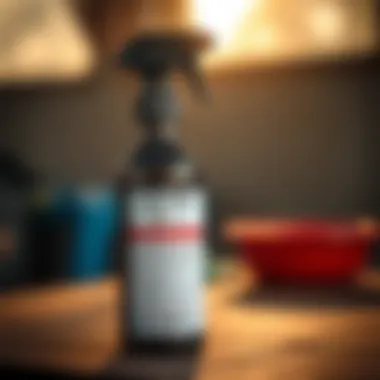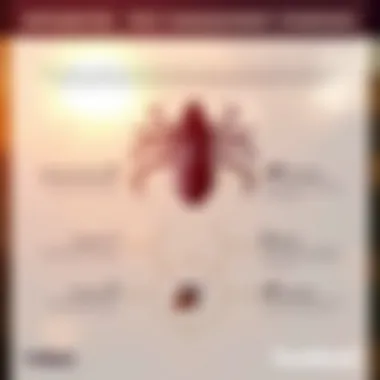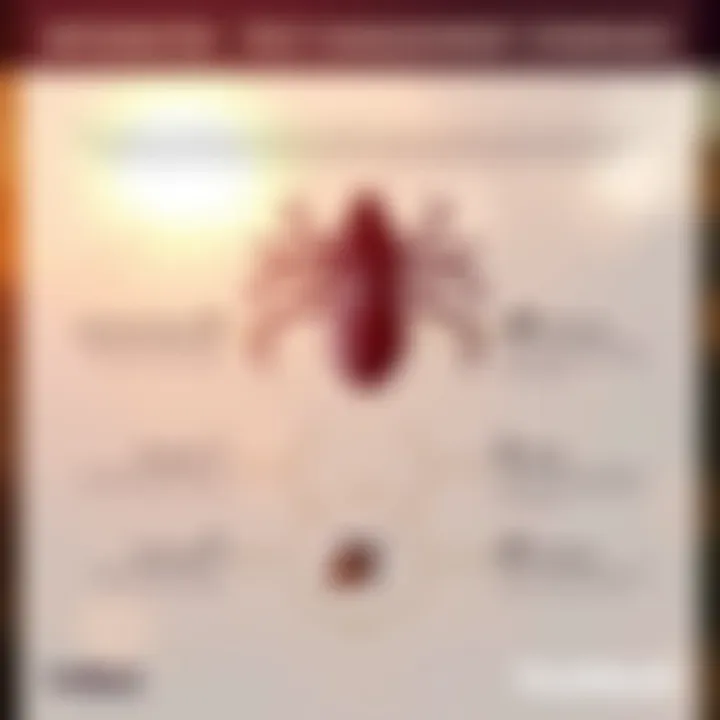Comprehensive Review of Cutter Flea and Tick Spray


Intro
Fleas and ticks are not just minor nuisances; they can pose real threats to the health of your pets and loved ones. For homeowners and housewives alike, keeping these pests at bay becomes a task that requires both awareness and action. This comprehensive piece delves into Cutter Flea and Tick Spray, offering a thorough analysis that spans its unique formulation, effective usage, and prospective safety measures. We aim to arm you with the knowledge needed to battle these pesky critters effectively.
Before diving into the specifics of Cutter's offerings, it’s crucial to first recognize the enemy we’re dealing with. Understanding pest identification can make all the difference in dealing with infestations head-on.
Pest Identification
Detailed Descriptions of Common Pests
In your quest to maintain a pest-free home, you might encounter several unwelcome guests:
- Fleas: Small, dark brown insects that feed on the blood of mammals. Their tiny size, about 1/8 inch long, makes them easily overlooked, yet they reproduce quickly—one female flea can lay around 50 eggs daily.
- Ticks: More prominent than fleas, ticks are usually brown or black and can attach themselves to the skin of pets and humans. They thrive in wooded areas and can carry diseases that affect both animals and people.
Signs and Symptoms of Infestations
Being aware of the signs of a flea or tick infestation is imperative. Some indicators include:
- Increased scratching or biting by pets: This might signal irritation from flea bites.
- Flea dirt: Tiny black specks found on pets or bedding, which are actually flea feces.
- Visible ticks: Often found in fur or on skin, they can appear as small, raised bumps.
Recognizing these signs early can help you take timely action before the problem escalates into a full-blown issue.
Prevention Strategies
Home Maintenance Tips for Pest Prevention
Keeping your environment clean and less inviting to pests involves straightforward strategies:
- Regular vacuuming: Frequent cleaning of carpets, rugs, and upholstery will help remove eggs and larvae.
- Washing bedding: Cleaning pet bedding weekly in hot water can eliminate fleas and ticks effectively.
Natural Deterrents and Barriers
Before you opt for chemical solutions, consider using natural deterrents:
- Cedar chips: These can be spread in gardens or around doorways to repel fleas.
- Essential oils: Mixing specific oils, such as lavender or peppermint, with water can create effective sprays that deter pests.
Treatment Options
Overview of Chemical vs. Natural Treatments
When it comes to pest control, you have various options to choose from. Chemical treatments, like Cutter Flea and Tick Spray, provide robust action against infestations and are often fast-acting. Natural treatments, on the other hand, tend to be safer, especially for households with children and pets but may need more frequent application.
Step-by-Step Guides for DIY Treatments
If opting for a DIY approach, here’s how you might create a simple flea spray:
- Gather ingredients: You will need water, apple cider vinegar, and a spray bottle.
- Mix: Combine equal parts of apple cider vinegar and water in the spray bottle.
- Application: Spray on affected areas, focusing on fabric and carpets. Reapply weekly.
This method can help control fleas but may not suffice for severe infestations, where Cutter’s specialized formula can effectively eradicate pests swiftly.
"Knowing how to identify and prevent pests gives homeowners an upper hand in maintaining a harmonious living environment."
Preface to Flea and Tick Infestations
Flea and tick infestations have become a growing concern, especially for pet owners and homeowners alike. Understanding these pests is crucial as they can bring significant discomfort not only to our furry friends but also to us, the humans. By grasping the nuances of flea and tick behavior, we can take effective steps to prevent infestations before they spiral out of control.
Understanding Fleas and Ticks
Biological Characteristics
Fleas and ticks, despite being small, have remarkable biological traits. Fleas, for instance, can jump impressive distances relative to their body size, allowing them to spread easily. They possess a hard outer shell, making them resistant to many forms of attack. Ticks, while different in appearance, also share unique qualities. They have specialized mouthparts designed to burrow into the skin of their hosts, making removal a challenging task. These characteristics allow them to thrive in various environments, which makes them a prevalent concern.
Key Characteristics
Both fleas and ticks are ectoparasites, meaning they live on the outside of the host. This leads to their survival strategies that keep them clinging on tightly while taking a blood meal. A notable feature is the flea’s ability to reproduce rapidly; a single female can lay up to 50 eggs a day. This significant reproductive capacity can lead to explosive population growth in short order, contributing greatly to pest challenges in homes.
Life Cycle of Fleas
The life cycle of fleas is another key factor in understanding their infestations. It encompasses four stages: egg, larva, pupa, and adult. Understanding these stages helps in targeting specific lifecycle points for pest control. The eggs are laid on the host or in the environment and can survive for several weeks in suitable conditions.
Unique Features
One of the important aspects of the flea life cycle is the pupa stage. Fleas can remain dormant for long periods, waiting for the right conditions before emerging as adults. This means that immediate removal efforts might not be enough without considering the lifecycle, which includes these resilient pupae.
Life Cycle of Ticks
Ticks have a more complex life cycle that includes larva, nymph, and adult stages. Unlike fleas, they require particular hosts for each stage of their life. Adult female ticks can lay thousands of eggs, which can further complicate control efforts. They are known for their excruciatingly long feeding periods, as they can remain attached to a host for several days.
Unique Features
One peculiar aspect of ticks is their questing behavior. Ticks crawl to the tips of grasses or leaves, reaching out with their front legs, waiting for a host to pass by. This behavior ensures they can access new hosts efficiently, increasing their opportunities for feeding and reproduction.
Impact of Fleas and Ticks on Pets and Humans
Health Risks to Pets
Fleas and ticks pose numerous health risks to pets. Flea bites can lead to allergic reactions, often resulting in itching and inflammation. The saliva of fleas may induce dermatitis, while ticks can transmit various diseases such as Lyme disease and Rocky Mountain spotted fever, which can lead to serious health issues if left unchecked.
Key Characteristics
As ectoparasites, both types of pests are capable of causing distress and illness in pets. The consequences of infestations are not just physical; they can lead to anxiety in pets that are constantly itching or feeling uneasy. Furthermore, repeated infestations can cause anemia in serious cases, especially in younger or weaker animals.
Health Risks to Humans


Although humans are not the primary host for fleas and ticks, we are not completely safe. Flea bites can cause discomfort and itching in humans too, and some individuals may have allergies that provoke further reactions. Ticks, however, are more dangerous as they can carry pathogens that cause serious diseases.
Key Characteristics
Ticks can lead to encephalitis, Lyme disease, and even other tick-borne illnesses that can have lasting effects if not treated swiftly. This risk makes awareness and preventative actions critical for anyone living in areas known for these pests.
Environmental Considerations
The presence of fleas and ticks also raises environmental concerns. Their rapid reproduction and ability to spread in various ecosystems highlight the need for targeted pest control strategies that do not harm beneficial insects or local wildlife.
Unique Features
One important note is that many chemical treatments can negatively affect non-target species. Aiming to control flea and tick populations must balance effectiveness with ecological responsibility. For effective management, methods must also include natural and organic treatments that work in harmony with the environment.
Cutter Flea and Tick Spray Overview
The topic surrounding Cutter Flea and Tick Spray plays a vital role in understanding how to manage pests effectively in our environments. This spray is not just another addition to pest control shelves; it brings a strategic approach to combating flea and tick infestations. House owners and pet owners alike seek reliable solutions, and this overview highlights important elements such as the active ingredients, their functions, and the best practices for application. Grasping these aspects lays a foundation for better pest management.
Active Ingredients and Their Functions
Pyrethrins
Pyrethrins, derived from chrysanthemum flowers, are notable for their quick knockdown ability against pests like fleas and ticks. Their natural origin makes them a popular choice among those leaning towards less synthetic solutions. A significant characteristic of pyrethrins is their effectiveness against a broad spectrum of pests while generally being low in toxicity for humans and pets. However, one must keep in mind that while they are effective, they may not provide a lasting residual effect, which could necessitate more frequent applications.
Permethrin
Permethrin is a synthetic derivative of pyrethrin, designed to enhance durability against insect populations. It is favored for its longer-lasting impact, allowing it to fend off ticks and fleas for an extended period compared to its natural counterpart. The main attribute of permethrin lies in its ability to remain effective on treated surfaces, ensuring continued protection. Nevertheless, it's crucial to handle permethrin with care as it exhibits higher toxicity to aquatic life, emphasizing the need for caution during application near water sources.
Other Inactive Ingredients
Inactive ingredients in Cutter Flea and Tick Spray serve various supportive roles that enhance the product's performance. They often include emulsifiers and stabilizers that help maintain the formulation's consistency, ensuring a reliable distribution of active ingredients during application. While they might not directly contribute to pest control, their presence is essential for improving the usability and effectiveness of the spray. An interesting point is that some of these ingredients could be responsibly sourced, further appealing to environmentally-conscious users.
Application Instructions
Preparation of the Area
Before using Cutter Flea and Tick Spray, preparing the area is an essential step that can often go overlooked. Checking for any signs of infestation and removing potential hiding spots can help maximize the spray’s efficacy. A clean slate ensures that the active ingredients can work their magic without interference from debris or clutter. This preparatory phase is incredibly beneficial as it sets the stage for a thorough application later on. It’s a simple yet crucial component of effective pest control.
Spray Application Techniques
When it comes to spray application techniques, the aim is consistent coverage without oversaturation. Utilizing a sweeping motion ensures even distribution across surfaces. Additionally, it’s advisable to target areas where fleas and ticks are likely to harbor, such as pet bedding, carpets, and baseboards. The distinctive feature of employing precise spray techniques is that it maximizes the effectiveness of the product, ensuring that no corner gets left out. Striking a balance between adequate coverage and not over-applying is key to optimization.
Post-Application Care
Post-application care involves taking necessary measures to maintain safety and effectiveness. It's recommended to keep pets and children away from treated areas until surfaces are completely dry. This precaution addresses the dual objective of protecting health while ensuring that the treatment remains effective. Furthermore, inspecting the treated areas regularly can help in spotting any signs of renewed infestations, allowing for timely interventions. This aftercare element is a valuable strategy for long-term pest management, making it an invaluable part of the overall process.
Key Takeaway: Proper preparation, application techniques, and post-application care can significantly enhance the success of Cutter Flea and Tick Spray, ensuring a pest-free living environment.
This section serves as a groundwork for understanding how each aspect of Cutter Flea and Tick Spray works together to provide effective pest control. By dissecting the composition and application methods, homeowners and pest control practitioners are better equipped to tackle flea and tick issues head-on.
Effectiveness of Cutter Flea and Tick Spray
The effectiveness of Cutter Flea and Tick Spray plays a pivotal role in this analysis, as it not only addresses the immediate concerns of pest control but also promises an ongoing solution for maintaining a pest-free environment. Understanding how effective this spray is in different situations can help homeowners make informed decisions about their pest management strategies. Here we’ll delve into specific elements such as how the spray performs indoors versus outdoors, and how long the effects last to assess its overall utility.
Efficacy in Various Conditions
Indoor Applications
Indoor applications of Cutter Flea and Tick Spray offer a specialized approach to keeping homes safe from infestations. This application method is often favored for its precision and ability to target local problems. One key characteristic of indoor use is its focus on concentrated areas where pests are likely to nest or thrive, such as carpets, pet bedding, or upholstery. This targeted approach minimizes waste and maximizes impact.
However, the unique feature of indoor applications is the ability to quickly address existing infestations without overwhelming the space. It's a popular choice for homeowners because it takes effect swiftly, allowing for peace of mind. There are, of course, disadvantages: one must take care not to overapply, or chemical residue might linger, which can be a concern for families with allergies or pets.
Outdoor Applications
Outdoor applications broaden the scope of pest control by encompassing larger areas where fleas and ticks can breed and propagate. Using Cutter Flea and Tick Spray outdoors can be highly effective, especially in yards and gardens that receive regular foot traffic. This spray’s formulation allows it to cover extensive grounds, connecting well with the often-overlooked hotspots around trees, bushes, and even patios.
The key characteristic here is the broad-spectrum efficiency it delivers against these pests in their natural habitat. Homeowners appreciate outdoor applications as they can preemptively tackle infestations before they encroach on living spaces. However, an essential aspect to consider is weather conditions; rain or excessive heat may dilute or disperse the spray, reducing its effectiveness.
Seasonal Considerations
Understanding the seasonal nature of flea and tick populations can significantly affect pest management. During warmer months, these pests thrive, and Cutter Flea and Tick Spray is especially effective in combating invasions from spring through autumn. This characteristic marks it as a beneficial tool during peak activity seasons.
The unique feature of seasonal consideration is that it allows homeowners to plan ahead, ensuring that applications coincide with the life cycles of fleas and ticks. That being said, relying solely on seasonal applications without a consistent treatment plan may lead to gaps in pest control, allowing populations to rebound.
Duration of Effectiveness
Immediate Effects
The immediate effects of Cutter Flea and Tick Spray offer a rapid response to infestations. As soon as it is applied, users often witness a notable decrease in pest presence. This quick action is crucial for households facing acute infestations, making it a sought-after option during emergencies.
The key advantage of this feature is that it provides relief and reassurance quickly. However, it is imperative for users to remember that while immediate results are impressive, they are just the first step in a broader pest control strategy, as continued vigilance is necessary for long-term success.
Long-term Control
Long-term control is where Cutter Flea and Tick Spray can shine when combined with a consistent regimen. Its formulation is designed to provide lasting protection against these pests, helping to mitigate their comeback. For those managing ongoing infestations, its attributes in maintaining a barrier against re-infestation can be valuable.
What sets this apart is its ability to work in conjunction with regular household cleaning and preventive measures, making it a robust choice for sustained protection. On the downside, long-term control demands reevaluation; if the pest environment is changed, the efficacy might decline, thus requiring adjustments in application techniques or frequency.
Reapplication Guidelines
Reapplication guidelines are essential for getting the most out of Cutter Flea and Tick Spray. Following the manufacturer's recommendations for when and how often to reapply is vital in maintaining control over flea and tick populations. One of the standout characteristics is the clarity of these instructions, which help harmonize the user’s efforts with the lifecycle of the pests.
The distinct feature here is the practicality of reapplying; users can incorporate this into their regular home maintenance routines. However, overlooking these guidelines can lead to reduced effectiveness, allowing pests to regroup. This aspect underscores the importance of diligence in following a structured pest management plan.
Safety Considerations


Safety considerations are pivotal when discussing pest control sprays, especially products like Cutter Flea and Tick Spray. This section emphasizes the significance of precautions and environmental practices to ensure both human and ecological safety. To effectively use these sprays while minimizing risks, understanding protective measures, symptoms related to overexposure, and environmental impacts is crucial.
Health Precautions
Personal Protective Equipment
When dealing with any chemical treatment, including Cutter Flea and Tick Spray, employing personal protective equipment (PPE) stands out as a foundational safety step. This equipment includes gloves, masks, and eye protection. The primary purpose of PPE is to create a barrier between the user and potentially harmful chemicals, thus significantly lowering the risk of adverse health effects. A key characteristic of PPE is that it helps to ensure a secure application environment. This is why many homeowners opt for PPE during application.
One unique feature of gloves is their ability to prevent skin contact with the pesticide, which can trigger allergic reactions or irritations. While masks guard against inhaling harmful fumes, eye protection prevents splashes from entering the eyes. Ignoring these measures can lead to serious health repercussions, so taking the time to gear up is crucial.
Symptoms of Overexposure
Recognizing symptoms of overexposure to flea and tick sprays is vital. Symptoms can range from mild skin irritation and headaches to more severe respiratory issues. Being aware of these warning signs contributes to a safer application process.
A key characteristic here is immediate recognition; soil issues might not manifest at first but can escalate rapidly. For example, when a person starts to feel dizzy or experiences nausea shortly after spraying, it could be a red flag of overexposure. Understanding these symptoms enables individuals to act quickly, ensuring safety for themselves and their pets. Addressing these symptoms promptly can prevent long-term health complications.
First Aid Measures
Understanding first aid measures related to exposure is essential. In the event of accidental exposure to pesticides, knowing how to respond can make a significant difference. A primary characteristic of first aid measures is immediate action. If someone gets a spray in their eyes, flushing with water for at least 15 minutes is crucial. Similarly, if there's skin contact, washing the area thoroughly helps in reducing irritation and prevents absorption.
These measures are beneficial as they not only mitigate immediate harm but also provide peace of mind for the user. Being prepared with this knowledge can often turn a daunting situation into one that is manageable. So, having access to a first aid kit that includes soap, water, and even a contact number for poison control is wise whenever pesticides are in play.
Environmental Concerns
Impact on Non-target Species
It's important to consider the ecological footprint of using Cutter Flea and Tick Spray, particularly its impact on non-target species. These sprays can inadvertently affect beneficial insects, such as bees and ladybugs, which are crucial for ecological balance. The effect of insecticides doesn't stop with the intended pests; harm often extends to surrounding wildlife and beneficial organisms.
A notable characteristic of this application is that many homeowners may not be aware of these ramifications. It becomes a double-edged sword; while aiming to control pest populations, there’s potential collateral damage to the environment. Before using any pesticide, weighing these impacts is an essential consideration for responsible homeowners.
Degradability of Ingredients
Selecting products with environmentally safe formulations is another integral part of safety considerations. Cutter Flea and Tick Spray includes ingredients that vary in their degradability. Effective pest control materials should break down quickly and not persist in the environment; this is crucial in preventing long-term ecological harm. Understanding the degradability properties of active ingredients can assist homeowners in making informed choices.
Choosing products with biodegradable ingredients reflects a commitment to sustainability. Harmful chemical residues can linger long after application, affecting soil and water quality. Therefore, the uniqueness of being eco-friendly should be a selling point when homeowners select pest management solutions. Avoiding products that resist breakdown is a step towards a healthier environment.
Water Safety
Water safety is a pressing concern when using pesticides. It is crucial to prevent run-off into nearby water bodies, which can adversely affect aquatic life. The main characteristic here is that chemical residues can seep into lakes, rivers, and streams, creating harmful conditions for fish and other wildlife. Paying attention to water safety is a significant advantage for those conscientious about environmental health.
When applying Cutter Flea and Tick Spray, homeowners are encouraged to avoid spraying on windy days and to refrain from treatment near bodies of water. The goal is to minimize the risk of contamination. This practice highlights steps that can be taken to promote both personal and ecological safety, reflecting a well-rounded approach to pest control.
To summarize, being aware of health precautions and environmental impacts can significantly enhance the safety of using Cutter Flea and Tick Spray. Taking the time to implement personal protective measures, recognize symptoms of overexposure, understand first aid, and consider the environmental effects are all steps towards responsible pest management.
Comparative Analysis with Competitors
When tackling the persistent problem of fleas and ticks, understanding where Cutter Flea and Tick Spray stands in the market is essential. A detailed comparative analysis helps consumers make informed decisions, weighing various factors such as effectiveness, cost, and user experiences. Knowing how Cutter measures up against other flea and tick sprays not only brings clarity but also guides homeowners in choosing the right pest control option for their unique situation.
Cutter vs. Other Flea and Tick Sprays
Efficacy Comparisons
The efficacy of any pest control product, including Cutter Flea and Tick Spray, is pivotal to its success. In straightforward terms, this means how well the spray can eliminate these pesky intruders from your living space. When compared to other solutions, Cutter's formulation features a blend of active ingredients known for their quick knockdown capabilities. Many users report immediate relief after application, and this instant reaction can make a world of difference in a chaotic household.
- Key Characteristic: Cutter is seen as a fast-acting solution, which prevents the prolonged suffering of pets and residents.
- Unique Feature: Its ability to eliminate fleas and ticks on contact sets it apart from others, providing almost immediate results.
- Advantages: You can expect a more comfortable immediate environment, which is crucial for families dealing with an infestation.
Cost-Effectiveness
Cost-effectiveness is another significant aspect of evaluating flea and tick control methods. While Cutter might come with a price tag similar to competitors, its reliability often leads many to view it as a worthwhile investment. When you consider the number of pests it can manage effectively, the value becomes clearer.
- Key Characteristic: This spray presents a balance between cost and performance.
- Unique Feature: It covers large areas efficiently, meaning you won’t need to invest in multiple bottles to deal with your yard and home.
- Advantages: Over time, choosing Cutter can lead to financial savings since it often reduces the need for additional treatments or products.
User Reviews and Feedback
User reviews are a reliable lens through which prospective buyers can assess the practicality of Cutter Flea and Tick Spray. Feedback from real-world experiences offers insights that marketing claims sometimes miss. Overall, many customers note high satisfaction levels, particularly when it comes to how well it addresses flea and tick problems.
- Key Characteristic: Positive reviews often cite the effective elimination of pests and improved home comfort thereafter.
- Unique Feature: People appreciate that it is versatile enough for indoor and outdoor use, catering to various needs across different environments.
- Advantages: Not only does this create a more comfortable living space, but it can also give peace of mind to concerned pet owners.
Natural Alternatives
With all the talk around chemical solutions, many homeowners are keen on exploring natural alternatives as a way to manage flea and tick populations. The explosion of organic pest control solutions has, of late, reshaped the market landscape. This part delves into how natural options compare for effectiveness, safety profiles, and application challenges.
Effectiveness
In discussing effectiveness regarding natural alternatives, it’s crucial to note that while they often tout safety, they may not pack the same punch as chemical sprays like Cutter. Natural options often utilize ingredients such as essential oils or diatomaceous earth, which can be great for prevention but less reliable once an infestation is established.
- Key Characteristic: Many natural alternatives are marketed as safe for pets and children, highlighting their appeal.
- Unique Feature: They are generally less toxic, which might be a game-changer for families with small kids or sensitive pets.
- Advantages: Buyers inclined toward a more eco-friendly lifestyle might favor these options, even if it requires a bit more effort on their part.
Safety Profiles
When discussing safety profiles, it's vital to understand both the benefits and drawbacks. Many natural alternatives offer a soothing scent and are low on harsh chemicals, fulfilling safety expectations for consumers prioritizing health. However, one downside could be that most are not as quick in eliminating pests compared to traditional methods.
- Key Characteristic: Reduced risk of harmful side effects or chemical exposure.
- Unique Feature: They tend to be biodegradable, meaning they leave a smaller carbon footprint.
- Advantages: Peace of mind can be a huge selling point for health-conscious families, even if the trade-off is a slower action against pests.
Application Challenges
The application challenges surrounding natural alternatives are noteworthy. From needing precise measurements of ingredients to ensuring consistent application, using these products often requires a learning curve. While Cutter is a spray-and-go type of product, natural alternatives might ask a little more of consumers.
- Key Characteristic: Their variable concentration levels can make results less predictable.
- Unique Feature: Because they often require mixing or specific dispersal methods, there can be a time investment.
- Advantages: For those willing to put in the work, the satisfaction of using a natural solution might outweigh the hassle.
Integrated Pest Management Strategies
Integrated Pest Management (IPM) strategies play a vital role in maintaining effective control over flea and tick infestations. The approach blends various methods to not only eliminate pests but also prevent their resurgence. Homeowners often face the question of how best to keep these irritating creatures at bay, and IPM provides a structured way to address this challenge. The beauty of IPM lies in its comprehensive nature, as it combines chemical, cultural, biological, and educational approaches to achieve long-term pest management goals without compromising safety or the environment.
Preventive Measures


Regular Pet Treatments
Regular pet treatments form the backbone of effective IPM strategies for fleas and ticks. Keeping pets treated with appropriate flea collars, topical treatments, or oral medication is crucial. These treatments prevent infestations before they even start, acting as the first line of defense. The key characteristic here is the preventive aspect—having pets protected can significantly reduce the risk of infestations migrating into living spaces.
One unique feature of regular pet treatments is the convenience factor; pet owners can easily apply topical solutions or use collars that last for months. However, it's important to remember that while regular applications are generally safe and effective, they must be done according to veterinary guidance. From a downside perspective, some pets may exhibit sensitivity to certain compounds, making it vital for owners to monitor their animals for any adverse reactions right after application.
Home Cleaning Practices
Home cleaning practices also play a pivotal role in controlling flea and tick populations. Regular vacuuming of carpets, furniture, and pet bedding significantly reduces the chances of an infestation taking root. This is particularly important as fleas and ticks often drop eggs in these areas, leading to new generations hatching without detection. The key characteristic of these cleaning practices is their ability to complement other pest control efforts seamlessly.
One of the unique features of rigorous home cleaning is that it is cost-effective and environmentally friendly. Using simple cleaning supplies like vinegar and baking soda can make a world of difference. However, cleanliness alone won't solve the problem; homeowners must commit to a consistent routine to truly see benefits. The downside remains that deep cleaning tasks can be labor-intensive, and maintaining them requires dedication from the household.
Yard Maintenance
Yard maintenance is another essential facet of an integrated pest management strategy. Fleas and ticks thrive in shaded, moist areas that an unkempt yard can provide. Keeping grass mowed, trimming shrubs, and clearing debris are all critical actions to dissuade these pests from making your yard their home. The key characteristic here is proactive management that can deter early infestations.
For instance, by introducing barriers, like cedar chips, around your home’s perimeter, you can provide an additional safeguard against these pests. While yard maintenance may require an initial time investment, the resulting peace of mind is invaluable. However, the downside is the necessity for ongoing maintenance; what looks good today can quickly become a breeding ground if left unattended.
Responding to Infestations
Identifying Infestation Sources
Identifying infestation sources is fundamental to addressing flea and tick problems effectively. Without pinpointing where these pests are entering and breeding, it’s tough to get a handle on the situation. This aspect of IPM emphasizes the importance of awareness; being observant of pets, yard conditions, and known hot spots can drastically increase the overall effectiveness of pest control measures.
A unique feature here is leveraging technological advances; some homeowners are now using digital pest control systems that notify them of pest activity. However, while identifying sources is critical, not every homeowner may have the expertise to accurately assess an infestation. This can lead to misdirected efforts if professionals aren’t consulted when needed.
Combining Treatment Options
Combining treatment options is a powerful strategy in pest management that can yield impressive results. Utilizing multiple methods—including chemical treatments, bait traps, and natural repellents—reinforces the pest control effort. The key characteristic is that it allows for flexibility, tailoring approaches based on specific situations or severity.
For example, while a chemical spray like Cutter Flea and Tick Spray may tackle existing infestations, introducing natural deterrents can prevent future issues. The unique advantage of this combined approach is that it counters the limitations of relying solely on one method. On the flip side, some homeowners may find the multitude of choices overwhelming, leading to confusion about what method to prioritize.
Monitoring and Follow-ups
Monitoring and follow-ups are crucial components in evaluating the success of any integrated pest management strategy. After treatments are applied, it’s essential to watch for signs of continued pest activity. This aspect emphasizes continuous attention, ensuring that the methods applied have the desired effect.
A unique feature of monitoring is the use of post-treatment inspections, which can provide peace of mind that the pest problem is under control. As with any preventative strategy, regular follow-ups are necessary. Nonetheless, some may find this process tedious or unnecessary if they believe their initial efforts were successful, which can inadvertently lead to recurring infestations.
"An ounce of prevention is worth a pound of cure."
In the fight against fleas and ticks, ensuring you are prepared with a robust IPM strategy can save time, effort, and resources. By focusing on these strategies, homeowners can not only reduce the likelihood of infestations but also promote a healthier living environment.
Common Myths and Misconceptions
Flea and tick management is shrouded in confusion and misinformation. Unraveling common myths is crucial as they can lead to ineffective treatment strategies and unnecessary panic. This section aims to clarify misunderstandings that homeowners might have regarding these pesky critters and the methods used to manage them.
Myth: Only Pets Can Carry Fleas and Ticks
Understanding Transmission
It's a common belief that only animals like dogs and cats harbor fleas and ticks; however, that's just a half-truth. These pests are quite adaptable and can latch onto humans and objects, including clothing. When pets roam outdoors, they can pick up fleas and ticks from the environment, which can then transfer to human hosts when in close contact. The key takeaway is: fleas and ticks don’t discriminate. They thrive on blood irrespective of the source. This perspective enriches our understanding of how infestations can start.
Role of the Environment
The environment plays an undeniable role in the lifecycle of these pests. Dense brush, tall grass, and even your own backyard can serve as breeding grounds. They prefer humid and warm areas, where they can easily harbor until they find a host. By focusing on environmental factors, homeowners can implement strategies to prevent infestations. Regularly maintaining yards and reducing potential habitats is not just advantageous; it’s essential.
Flea and Tick Life Stages
Understanding the life cycle stages of fleas and ticks provides insight into their resilience. Fleas, for instance, can exist in several forms: eggs, larvae, pupae, and adults. Each stage requires different management tactics. Ticks also go through distinct stages that make them remarkably hardy. Knowing their life cycle helps in predicting potential outbreaks and determining the right timing for treatment. If you aim to manage fleas and ticks effectively, internalizing their life stages is highly beneficial.
Myth: Chemical Sprays Are Always Dangerous
Clarifying Safety Standards
Fear often arises from the word
Finale
The conclusion serves as a pivotal element in summarizing the extensive discussion on Cutter Flea and Tick Spray. It emphasizes the significance of understanding the product within the context of overall pest management strategies. As a homeowner or pet owner, comprehending the myriad factors surrounding flea and tick control is vital in ensuring the health and well-being of both your pets and family.
Summary of Findings
Recap of Effectiveness
In the realm of pest control, the effectiveness of any solution comes to the forefront. Cutter Flea and Tick Spray has proven to be a practical choice for many home environments. With its unique blend of active ingredients, this spray combats fleas and ticks effectively, contributing to a notable reduction in pest populations. Homeowners value it not just for its immediate efficacy but also for the long-lasting results it provides. This characteristic aids in reassuring users that they are making a wise investment in pest control.
Safety and Environmental Considerations
Equally important in this conversation is the safety and environmental footprint of the chosen pest control method. Cutter’s formulation boasts a favorable safety profile when used as directed, making it a popular choice among those concerned about health implications for pets and humans. Moreover, the consideration of environmental factors is paramount. Many homeowners seek solutions that minimize harm to non-target species and maintain ecological balance. This product's careful ingredient selection reflects a commitment to safer pest management, thereby finding a favorable position among conscientious users.
Importance of Integrated Strategies
Moreover, the significance of integrated strategies can't be overstated. Understanding that pest control is not merely about applying a spray, but integrating multiple avenues of prevention and response elevates the conversation. Regular pet treatments, home hygiene practices, and outdoor maintenance contribute to sustaining a pest-free environment. Advocating for a comprehensive approach allows homeowners to utilize Cutter Flea and Tick Spray as part of a broader scheme, boosting its effectiveness and ensuring a more enduring resolution against infestations.
Future Directions in Pest Control
Research Advancements
As we delve deeper into pest control solutions, research advancements set the stage for the ever-evolving battle against these pests. Cutting-edge studies focused on flea and tick biology offer insight that potentially redefines existing treatments. The integration of innovative tools and methods leads to enhanced efficacy and safety. Homeowners should watch for these developments as they are critical in unlocking new possibilities in managing pests effectively.
Emerging Treatments
Emerging treatments are another area to keep an eye on. The landscape of pest control solutions is shifting, with natural products and formulations gaining traction. These innovations often boast less toxicity and environmental burden, which resonates well with modern consumer preferences. By staying informed about these developments, homeowners can explore options that may align better with their values and needs, enhancing their arsenal against fleas and ticks.
Trends in Consumer Preferences
Furthermore, trends in consumer preferences reveal a growing demand for transparency and sustainability in pest control. Many buyers are looking for products that not only deliver results but also align with their ethical values. This shift is prompting manufacturers to rethink their formulations. Cutter Flea and Tick Spray stands to benefit from this trend, especially if it continues to embrace the balance between efficacy, safety, and environmental responsibility.
"Understanding the evolving landscape of pest control not only empowers homeowners but secures the well-being of their households."
In summary, Cutter Flea and Tick Spray represents a cornerstone of effective pest management. By understanding its effectiveness, safety considerations, and broader implications of integrated pest strategies, homeowners can navigate the complexities of pest control with greater assurance.



